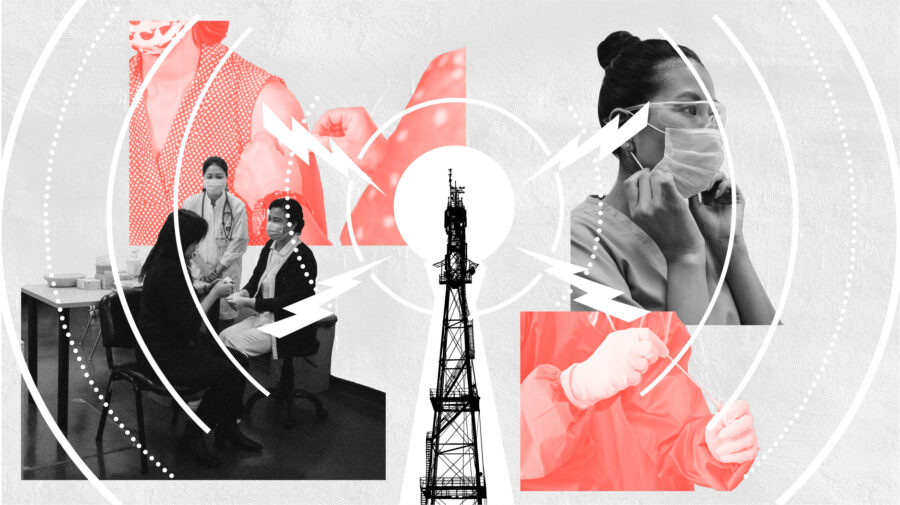This is the first in an ongoing First Draft series on narratives about China’s vaccines. Forthcoming entries will explore how China’s vaccines are discussed — sometimes in misleading ways — around the world.
On May 7, the World Health Organization (WHO) listed the Chinese-made Sinopharm Covid-19 vaccine for emergency use.
“The addition of this vaccine has the potential to rapidly accelerate COVID-19 vaccine access for countries seeking to protect health workers and populations at risk,” a WHO official said in an online statement.
The news may have come as a surprise to some. China has been criticized for failing to provide sufficient data about its homegrown vaccines, and for attacking vaccines made by US and European pharmaceutical companies with unsubstantiated claims and even conspiracy theories. Research earlier this year pointed to a network of pro-China social media accounts disseminating vaccine disinformation.
At the same time, Chinese-made vaccines have been the subject of misleading narratives, which could undermine confidence in them. Skepticism about vaccines from China could impede global health officials’ effort to use the shots to fill gaps in the global vaccine supply.
Some of the misleading narratives about China’s vaccines appear on the Mandarin- and Cantonese-language websites of Radio Free Asia (RFA), a news outlet funded by the US government. RFA’s two Chinese sites have a combined following of over 1.4 million on Facebook, Twitter and YouTube.
A First Draft review of coverage of vaccines on the sites found a number of questionable narratives about China’s vaccines — particularly the Sinopharm shot as well as Sinovac (also known as Coronavac).
Radio Free Asia is funded by the US Agency for Global Media, an independent US government agency, and retains editorial independence. Its stated mission is “to deliver uncensored, domestic news and information” to countries in Asia “with poor media environments and few, if any, free speech protections.” US legislators are considering a bill that includes increased funding for RFA’s Mandarin-, Tibetan-, Uyghur- and Cantonese-language services as part of an effort to “counter [Chinese Communist Party] propaganda and disinformation.”
But a review of RFA’s recent vaccines coverage points to a possible tension between the mission of countering state-led disinformation and providing balanced coverage about public health.
The narratives
Some of the RFA articles reviewed lacked key context in describing purported issues with Chinese-made vaccines. This could enable the spread of anti-vaccine misinformation at a time when research suggests that exposure to online misinformation about vaccines can increase rates of vaccine hesitancy.
In one example, a November 10 article on RFA’s Cantonese website, headlined “Clinical trial of Chinese vaccine halted in Brazil after causing serious incident,” lacked important context from local authorities. A serious incident had indeed occurred: the death of a participant in a local trial of the Sinovac vaccine. But Reuters reported November 9 that the death had been deemed a suicide and that an official had denied any link to the vaccine, a detail not noted in RFA’s article.
The article, presented as a news story, also contained editorial comment dismissing China’s approach to vaccines. “This accident not only renews criticism of the ‘Great Leap Forward’-style of vaccine research and development, but also presents a serious setback for China, which is devoting all of its resources to this Covid-19 vaccine competition,” the first paragraph reads. RFA continued to describe the trial’s suspension as owing to “severe adverse effects,” not mentioning the participant’s reported cause of death, in at least two subsequent articles.
Another article dated March 8 was headlined, “Peru media reports Sinopharm efficacy as low as 11.5 percent, China banning negative coverage.” The RFA article attributed the efficacy “statistic” to remarks by a former top Peruvian health official on a local TV news program. The official, Ernesto Bustamante, was at the time an opposition candidate for a seat in Peru’s Congress, which he won in April. At the time, local media had already reported that the Peruvian clinical trial of the Sinopharm shot was still ongoing and that its final result wouldn’t be made public until at least May. And by the time of RFA’s article, Bustamante had already clarified that he merely had been reading the text of a leaked preliminary report provided to him by the TV program hosting him. Peru’s Ministry of Health had cautioned against making any interpretation based on the data, which had not yet been finalized. One Peruvian medical scholar accused the network that aired Bustamante’s comments of running a “disinformation campaign.”
The RFA article that amplified Bustamante’s misleading claims also contained editorial comment about China’s vaccination program. “While advanced countries had successfully developed vaccines, the Chinese government, rather than supplying its own people with enough doses, has been promoting ‘vaccine diplomacy.’ Despite paying a very high cost, the result has been a failure,” it reads. The article has been shared at least 800 times on Facebook and was reprinted on Apple Daily, a popular tabloid in Hong Kong and Taiwan.
RFA’s articles about Peru and Brazil were cited by the newspaper The Epoch Times, in two pieces that resembled the RFA stories and similarly lacked key context. The Epoch Times has been described as a source of anti-vaccine misinformation.
In their overall coverage of vaccines, the two RFA Chinese sites have in recent months rarely reported on the suspected adverse events linked to the main Western-manufactured Covid-19 vaccines. The sites did not cover the temporary suspension of the Johnson & Johnson vaccine in the US and Europe because of a rare type of blood-clotting disorder in a small number of recipients. However, 31 Chinese-language stories were devoted to reported issues with Chinese-made vaccines, including stories about individual cases of adverse effects or “breakthrough” Covid-19 illness, or about hesitancy or objection toward taking the vaccines.
During one week in early March, RFA’s two Chinese-language sites published nine articles about Hong Kong residents who became ill after receiving the Sinovac vaccine. One of these articles was headlined, “Sinovac vaccine cause multiple severe events in Hong Kong, two deaths, two hospitalized.” Another headline for an article on the same day read, “Vaccine hesitancy in Hong Kong skyrockets as Covid vaccines cause frequent severe adverse reactions.” In subsequent press releases, officials in Hong Kong have said they haven’t yet found a “causal relationship” or any “clinical evidence” of a link between the post-vaccine illnesses and deaths reported and either the Sinovac or Pfizer-BioNTech vaccine, which has also been authorized in the city.
On top of several articles that lacked context and were potentially misleading, most of the sites’ recent vaccines coverage overall focuses on the Chinese-made vaccines, and was predominantly negative.
First Draft generated a list of 175 headlines containing “疫苗,” the Chinese-language term for “vaccine,” published between November 9 and April 30. First Draft found that 138 of the articles mentioned Chinese-made vaccines, and of them, at least 93 took a negative perspective on the vaccines.
Yini Zhang, an assistant professor of communications at the University at Buffalo who studies public opinion and partisan news sources, likened RFA’s overall vaccine coverage to that of right-leaning outlets in the US that “exaggerate the side effects or the danger of COVID vaccines.”
“It’s a similar level of negativity about the vaccine. But in this case, it’s more about the Chinese vaccines,” she said after reviewing First Draft’s analysis.
Why this matters
Wen-Ying Sylvia Chou, a public health communication scientist and program director at the National Cancer Institute and co-author of several papers on Covid vaccine confidence, described the practice of emphasizing individual cases of adverse effects as “a slippery slope.”
“You can write a story about someone’s experience and just don’t make that attribution very clear. In a way, you’re not lying but by extension, you’ve conveyed some concern that has the same effect as if it was a piece of falsehood,” she said.
“By reporting hesitancy, you may actually cause more hesitancy,” she added.
Masato Kajimoto, a misinformation expert and journalism professor at The University of Hong Kong, said RFA’s Chinese-language websites and social media sometimes amplify anti-Beijing or Hong Kong government social media posts with low engagement, or even repeat unsubstantiated claims made by media outlets such as The Epoch Times.
“They’re clearly politically inclined toward one side. That’s reflected in the headlines that you’ve gone through,” said Kajimoto after reviewing First Draft’s data and analysis.
Glen Nowak, director of the Center for Health and Risk Communication at the University of Georgia, said academic research has shown that a media outlet’s frequent coverage of the same story and same narrative has an impact on those who rely on it.
“They can use these headlines and these kinds of stories as support for their position. And even if it just causes other people to become uncertain, that’s a win,” said Nowak, who previously served as a senior communication official at the Centers for Disease Control and Prevention.
Both Nowak and Zhang cautioned that determining how the coverage of a single outlet, such as RFA, affects readers’ confidence in vaccines would require more rigorous research and analysis.
Launched in 1996, RFA publishes in English and nine other languages spoken in Asia. Its reporting on human rights violations in Myanmar, China’s Xinjiang region and elsewhere has received praise and awards. Some of its journalists face harassment, assault and even imprisonment in the countries where they work.
Bay Fang, RFA’s president, said during a March discussion on publicly funded outlets, hosted by the Foreign Correspondents’ Club in Hong Kong, that “[o]ur job is not to do propaganda.”
“Our job is to model what a free press can look like in countries that don’t have it,” said Fang, a foreign correspondent based in China in the 1990s and 2000s before serving in the State Department during the Obama Administration.
Radio Free Asia declined an interview request, citing a scheduling conflict. In an email, Rohit Mahajan, RFA’s vice president of communications and external relations, wrote in response to First Draft’s questions about its coverage, “It’s very helpful to get feedback, especially regarding the accuracy of our coverage. RFA’s journalists and journalism are held to our Code of Ethics, and our mission is bringing free press to closed societies.”
Methodology
First Draft searched Radio Free Asia’s Mandarin- and Cantonese-language sites for “疫苗,” the Chinese-language term for vaccine, and found 175 articles with headlines matching the term between November 9 and April 30. A team of three Chinese-speaking researchers reviewed the 175 articles to determine whether they were related to Chinese-made vaccines, and whether they offered favorable or unfavorable coverage. An article was only marked as offering “negative” coverage of Chinese-made vaccines if all three researchers agreed on the rating.
Esther Chan, Stevie Zhang and Rory Smith contributed to this article.






